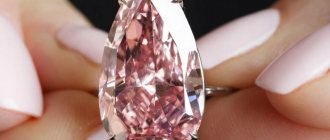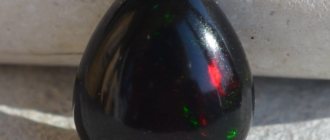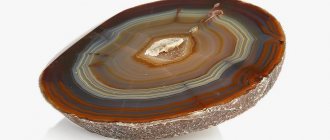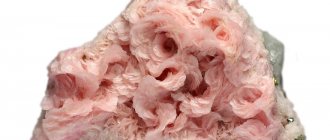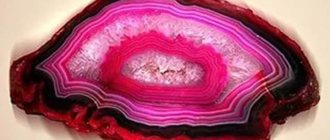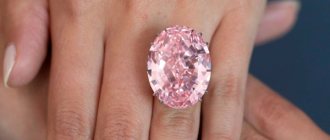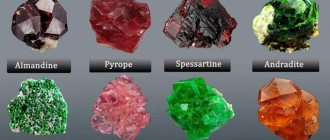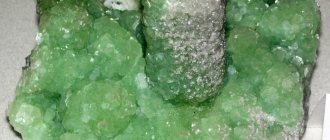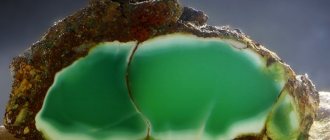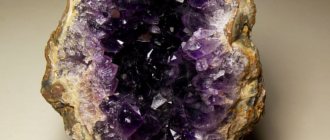But not only fashionistas love pink opal. The stone also has magical properties, as well as healing ones. So occultists, magicians, lithotherapists from all over the world are looking for delicate pink gems for their practices.
Origin of the mineral
Pink opals stand a little apart from other members of their family. Their main exporters are Peru and Mexico, where before the Spanish conquest there were powerful states of the Indians - Mayans, Aztecs, Incas. These peoples considered the stones sacred. According to Indian beliefs, the gods can look at the world through opals, and those who peer at them will be able to see higher powers. Therefore, Indian idols often have precious gems inserted in place of their eyes.
Pink opals were first discovered in what is now Peru and Mexico.
The conquistadors were not interested in pink crystals. When they captured Indian sanctuaries, they melted the gold statues into ingots, and simply picked out the stones and threw them away, without giving them any value. It is not known who was the first to decide not to discard the opal with contempt, but to send it home along with the rest of the loot.
One way or another, the dawn-colored opal ended up in Spain, where it almost immediately attracted the attention of fashionistas, craftsmen, and jewelers. Soon the belief spread throughout Europe that the stone helps maintain pale skin and blond hair color. The aristocracy of Spain, Portugal, and to a lesser extent Sicily were very proud of these features. It was believed that the snow-white skin and golden hair of the nobles was proof that their ancestors did not mix with the Moors.
Main characteristics of pink opal
If you look at pink opal from the point of view of geology and mineralogy, it represents a large fraction of red silica, which is “wedged” into the parent rock. Technically, the stone is not a crystal - it is an amorphous structure that consists of tiny globules, so the gem is very fragile. The raw rock appears as a round, oval or wedge-shaped conglomerate.
Pink opal is a semi-precious stone with magical and healing properties.
Pink stone is also called Andean or Peruvian opal. It is the most delicate, romantic, pastel variety of its family. With the exception of color, all its other properties coincide with its relative minerals:
- pearl, matte shimmer;
- full or partial transparency;
- absence of adhesions;
- softness and fragility due to the amorphous structure;
- vulnerability to alkalis, which can completely dissolve the gem.
According to jewelry classification, pink stone is considered semi-precious. Its cost is the same as that of its blue and black relatives. It is quite difficult to process; not every jeweler is ready to take on such a task.
Varieties of artificial opals
Gilson opal - first sold in Switzerland in 1972. It is the most expensive among synthetic stones; the mineral contains no water at all, so it is very stable. Externally it is very similar to natural stone, and is formed in about 18 months.
Kyocera opal is made in Japan from hydrated silicon oxide, the structure closest to natural stones.
Slocum stone is considered one of the best imitations of precious opals; the mineral was created in 1964 from silicon glass alloys enriched with sodium and aluminum particles, which give a rainbow effect.
They also developed a plastic copy of the stone, which the Japanese called neo-opal or pastoral opal. In the USA, milky blue opalite is produced from polystyrene, coated with acrylic resin.
Where is pink opal mined?
The veins from which pink opal is mined usually appear as thin but extended inclusions or biconvex lenses. Most often they are sandwiched between other rocks. The mineral deposits are not very rich, but are found regularly.
The leaders in the extraction of pink opals are the countries of Latin America.
As in the Middle Ages, the gem is mined in the Andes and Cordillera - the mountains of Central and South America. Development is carried out in an open way. It is often carried out in artisanal conditions by local residents themselves, who sell stones to buyers in large cities. The main suppliers to the market are, as you might guess, Latin American countries:
- Mexico;
- Guatemala;
- Honduras;
- Brazil;
- Peru.
Outside the Western Hemisphere, deposits have been discovered in Ethiopia. In recent years, mining of pastel opals has also intensified in Australia. This country even declared the stones its national treasure.
Price
The price of pink opal is determined depending on certain factors:
- the presence of precious metals in the frame;
- size and number of gems;
- other minerals in decoration.
Jewelry without an expensive frame can be purchased for prices ranging from 1,000 rubles to 3,000 rubles, depending on the number and nature of inclusions and the opalescence effect. Pink opals in gold or silver will cost 5,000–10,000 rubles.
Pink opal will be a good addition to your wardrobe, will help improve your personal life and give you self-confidence and strength. In return, you just need to be an honest person and take good care of your jewelry.
What outfit would you wear pink opal jewelry with? Tell us about your ideas in the comments below the article, share information on social networking pages.
Source
Use and care of stone
Pink opal is mined in relatively small quantities, and the specimens are usually not large. Therefore, the gem is used only in jewelry. It is set in gold or silver, and beads, earrings, and bracelets are made from it. Craftsmen often make souvenirs from it - boxes, chests, snuff boxes, smoking pipes, writing instruments, paperweights, figurines. The cut is usually made in the form of a cabochon.
Only with proper storage will a talisman with pink opal serve you for many years.
The mineral is used in stone magic and mineral therapy. In order for the magical properties of the pink opal stone to be preserved as long as possible, the amulet must be properly cared for. However, even if you do not believe in the supernatural properties of gems, the rules of careful handling of them will still come in handy. Even if the crystal is just a decoration for you, damaging or ruining it will still be a nuisance.
- Put on the gem only after you have already applied makeup. This is necessary so as not to accidentally stain the stone.
- It is best to store the stone in a separate, individual package. If this is not possible, at least keep away from hard minerals (diamonds, beryl). They can “push” the opal, disrupting its shape.
- The fragile Andean stone does not like temperature changes. Therefore, wear it under your clothes in winter.
- It is not recommended to leave the crystal in direct sunlight for a long time. This causes it to become cloudy, dry out, and even crack.
- If you use pink opal as a magical item, charge it only under the Moon, preferably waxing or full.
- When removing a gem, wrap it in soft cloth.
- Protect the mineral from shock, friction, and shock.
- Clean your jewelry under cool running water once a month.
If stored properly, the talisman will serve you for many years. If the opal becomes damaged or very dirty, do not attempt to fix it yourself. It's better to take it to a jeweler and he'll see what he can do.
Opal jewelry
Pink opal is a precious gemstone. The delicate color and texture of an amorphous mineral rarely suggests cutting. The stone looks best in a round or oval cabochon. The relatively vulnerable gem is used as an insert in jewelry. A durable frame made of silver or gold serves as a worthy decoration and protector for a delicate stone.
The cool shine of silver accentuates the delicate luxury of the mineral. Opal beads or bracelets are gorgeous, but if they are frameless, they require especially careful wearing.
The pink color range of opal ranges from the most delicate mother-of-pearl to dense dense. This makes jewelry suitable for women of any age. For young ladies, a silver jewelry with a dawn-colored pebble is suitable. Respectable ladies will prefer darker options, in gold.
In products, the gem is combined with jade, malachite, aquamarine, garnet and topaz. The cost of Andean opal is $2–5 per carat.
Checking pink opal for authenticity
Like other stones, pink opal is counterfeited quite often. Usually scammers imitate the Andean gem using painted glass or plastic. More “high pilotage” are synthetic minerals, which they learned to grow shortly after the Second World War. One way or another, their cost is lower than that of real crystals. How can you avoid being deceived?
Be sure to check the product with the stone for authenticity before purchasing.
- Expose your purchase to the sun's rays. Natural opal casts colorful reflections on the hand.
- Counterfeits do not stick to the tongue, unlike real gems.
- If the color is not uniform, it will be clearly zonal: some areas are clearly darker than others, without transitions.
- The transparent specimen plays with reflected light appearing somewhere in the depths of the pink stone.
- At different viewing angles, the colored inclusions will move and change shade. This phenomenon is called opalescence, and it is very difficult to fake.
- Examine the crystal under a magnifying glass. The natural pink mineral consists of tiny globules. Plastic and glass are homogeneous. Laboratory synthetic opals have a layered structure.
- Squeeze the gem in your hand. Real stone will heat up slowly. Glass - instantly.
When purchasing Andean opal, you should remember: only the original has magical and therapeutic properties. From an esoteric point of view, laboratory specimens are simply beautiful toys.
Original or imitation
Considering the low cost of the stone, it is wrong to think that it is often counterfeited. Nevertheless, such cases do occur. Wanting to reduce the cost of products, unscrupulous sellers actually pass off glass and plastic as pink opal.
It's not difficult to spot a fake. Both plastic and glass imitation are several times lighter than the original mineral, and all because they contain no water at all. A fake can also be identified by its unnatural, uneven color with sparkles instead of the natural inner lights of the opal shining in the light.
Healing properties of the stone
Pink opal has been used in mineral healing ever since it came to Europe. Lithotherapists believe that it is able to relieve heart pain and improve blood circulation. Also in alternative medicine, with its help they try to improve metabolic processes, improve potency in men over forty, and treat female frigidity.
Regularly wearing pink opal is a good way to prevent gastrointestinal diseases.
In people who have achieved harmony with their talisman, blood supply to the brain improves, the consequences of strokes pass faster, and the frequency of hypertensive crises decreases. The mineral can also stimulate the immune system. Therefore, it is recommended to wear it during seasonal epidemics of flu and colds, especially if your work involves a large number of people.
There is an opinion that pink opal stone has a good effect on the functioning of the liver and gallbladder. It can be worn if you have hepatitis or problems with bile production. The mineral will also be a good help for liver cirrhosis caused by alcohol intake.
The liver is responsible for processing all kinds of junk food through the production of bile. If you are planning a party with a lot of fatty food or alcohol, wear a gem to better endure the libations.
By applying a pink crystal to sore spots, you can reduce the intensity of pain and inflammation. Proper meditation on it can improve vision. Patients who regularly wear Andean opal recover faster after surgery. The energy of the gem helps to cope with neuroses, depression, and anxiety.
When resorting to unconventional methods of treatment, you should remember that they are experimental and are not always confirmed by science. It is best to combine the use of pharmacological drugs with lithotherapy. This is reasonable also because minerals work on the energetic level, and medicines work on the bodily, physical level.
The magical properties of pink opal
The properties of pink opal are determined by its color range. The delicate, pastel color of the mineral determines its energy, which helps to improve personal life or return peace to the family. This is a well-known love amulet.
Pink opal will help you meet a couple for a serious relationship.
- Those who suffer from unrequited or lost love should remember that intense feelings almost never last forever. If you do not exaggerate your suffering and its consequences, and do not “feed” the feeling, it will subside within two to four weeks. Meditation on pink opal will help you with this.
- It will be easier for someone who carries Andean opal to fight depression, apathy, and melancholy, especially if they are caused by loneliness or separation.
- The pink crystal symbolizes calm, peace, silence. When the wearer begins to be overcome by violent emotions, the talisman helps reduce their intensity.
- Keeping a souvenir of an Andean gem on your desk can improve relationships with managers and employees.
All opal stones have an interesting property: their character is absolutely neutral. Such a jewel can equally help to do both good and evil. However, any immoral acts and black magic lead to retribution, so you should not engage in them, even though at first glance it may seem effective.
When working with pink opal, you should be especially attentive to your mood and emotional background. You should not begin the ritual if you are angry, irritated, or feeling unwell. Peruvian opal can bring back your own negativity, creating even more problems. But if you take on work in a good mood, the gem will become a real magnet for success.
Zodiac compatibility
Due to its water content, opal is an absolutely “water” stone. It is optimally suited for Pisces, who often have excessive modesty, especially those who suffer from psychological complexes.
Earrings with pink opal
In principle, the mineral is suitable for people born under any zodiac sign, with the exception of those born in the year of the Fire Tiger or Water Snake - the stone will work the other way around, enhancing the negative traits of these people.
| Zodiac sign | Compatibility |
| Aries | — |
| Taurus | + |
| Twins | + |
| Cancer | + |
| a lion | — |
| Virgo | + |
| Scales | + |
| Scorpion | +++ |
| Sagittarius | + |
| Capricorn | + |
| Aquarius | + |
| Fish | +++ |
(“+++” – fits perfectly, “+” – can be worn, “-” – is strictly contraindicated)
Who is pink opal suitable for?
The properties a pink opal stone will exhibit when worn depend on many factors. Perhaps the most important among them is the sign under which the bearer was born. Libra best . Such people are often characterized by excessive perfectionism and inflated demands on themselves or others. At the same time, they are changeable, prone to sudden mood swings. The crystal will help you look at the world more realistically, without expecting too much from yourself and others. Also, the Andean mineral will balance changes in the emotional background.
Astrologers do not recommend using pink opal as a talisman for fiery zodiac signs.
Another pink gem is suitable for Gemini and Capricorn . He will make them calmer, more balanced, more peaceful. The energy of the crystal will soften natural egoism, a tendency towards tediousness, and scolding. Geminis become more purposeful and stop procrastinating, wasting time on useless little things.
Aries , Sagittarius and Leo to wear pink opal . Their fiery nature risks coming into conflict with the soft energy of the gem. It is better for such people to pay attention to the fire stone, which we recently wrote about.
As for the other signs, they can achieve harmony with the gem. But in order for something to change in life, you need to work on it yourself, and the talisman will already help with this.
How to avoid becoming a victim of scammers
Fraudsters sometimes try to sell synthetic or simply colored glass under the guise of a natural mineral. Such stones quickly lose their attractiveness and cannot boast of a soft glow or magical properties.
In order not to fall for the bait of unscrupulous sellers, it is recommended that you familiarize yourself with the main characteristics of the natural breed:
- Natural pink opal is smooth, not rough. Its surface should be checked not with your fingers, but with the tip of your tongue.
- On the surface of artificial stones the boundaries between different colors are sharp, but on the surface they are natural – smooth, soft.
- Natural minerals are translucent in bright light; fakes do not have this effect.
- If you examine pink opal in the sun, you will notice a slight shimmer, which is not typical for fakes.
View this post on Instagram
Posted by Trendy Jewelry (@studio.vintage) Jun 3, 2022 at 1:22 PDT
